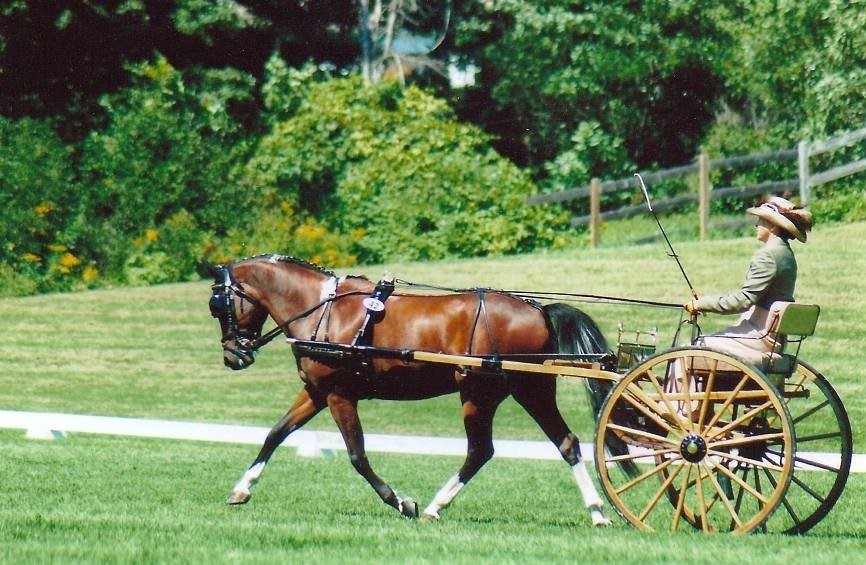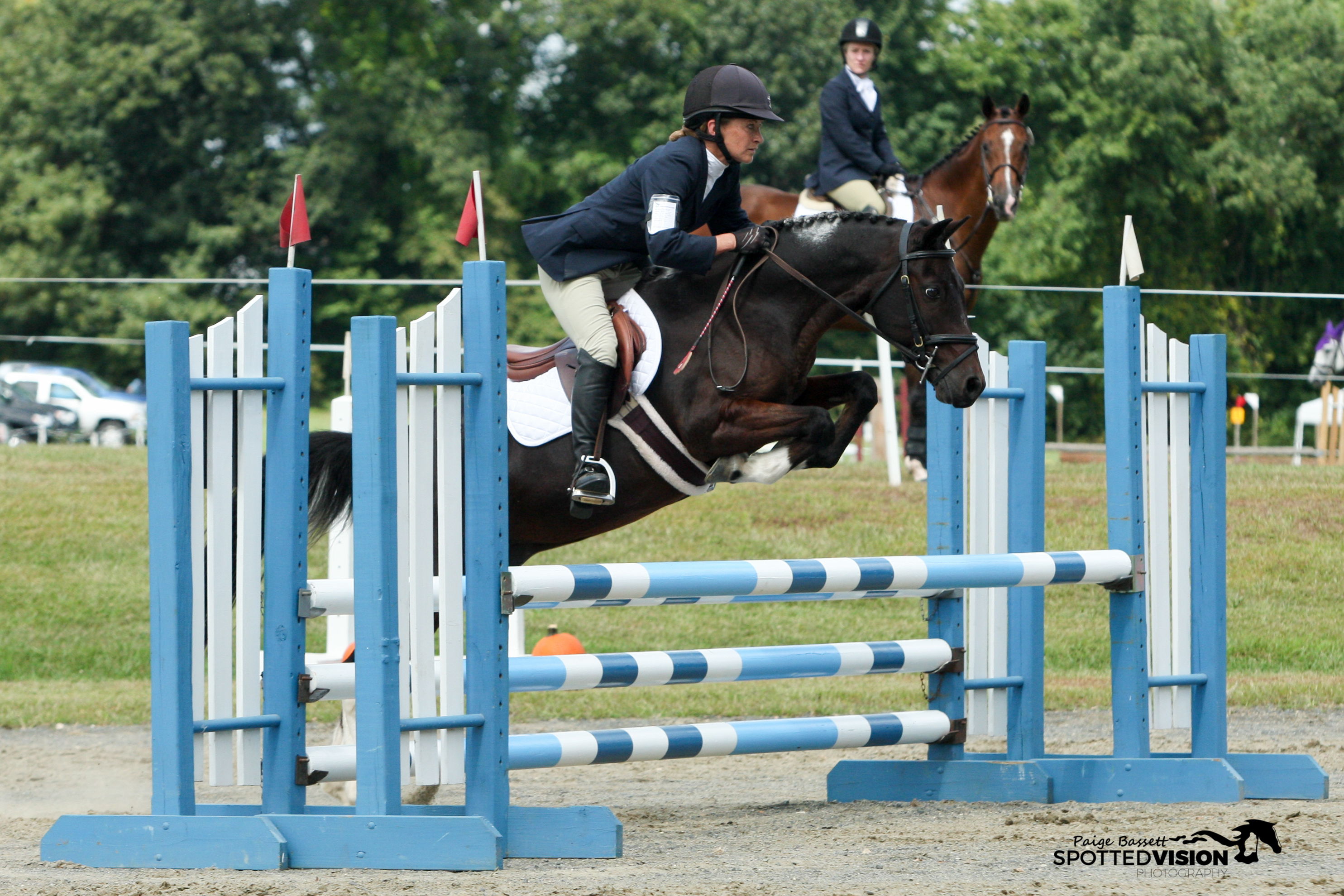Now on Course: From the Driving Course to the Cross-Country Course

Sixty-three-year-old Anne Burkhardt sat on a horse for the first time when she was 7 years old. “Our neighbors had horses, and it was a big thing for me as a kid but it was a backyard kind of situation,” she shared. “It wasn’t until later on in life that I got more involved and started going to sanctioned events. But it got me started!”
Fast forward to when Burkhardt was working in Maryland. She had taken a break from horses while in graduate school, and she decided that she wanted to get back into riding. “I ended up going to a tack shop and answering an ad on the bulletin board to muck stalls in Potomac, Maryland,” she said. “When I started doing that I ended up at a barn where a man kept his foxhunting horses and I asked if I could try eventing them, because I’d always wanted to do it.”
Burkhardt spent a couple of years playing around in eventing with the fox hunters, and after dipping her toe in the eventing world, she decided to purchase a Thoroughbred off the track. She took him with her to New Jersey, where she was moving for work. “I was there in the heyday of Bruce Davidson clinics – I even had a T-shirt that said, ‘I survived the Bruce David clinic!’” she said. “Robert Dover was in the area, Anne Kursinski, Stephen Bradley, people that you could clinic with. I even used to take jumping lessons with Kevin Babbington when he was starting out.”
“That time was the biggest growth spurt for me,” Burkhardt reflected. “I loved it. My Thoroughbred and I got up to the Training level and then he got diagnosed with navicular, so we switched to the Child/Adult Jumpers and did that for a few years before it got to the point that I had to retire him. I had amazing trainers and amazing friends in the eventing community that brought me along.”

Then, Burkhardt’s work took her to Boston. She still had her Thoroughbred with her, now fully retired, and decided to get him a companion pony. Burkhardt drove to Maine with her barn manager to pick up a pony she’d found for sale. “He was out with 200 head of cattle and we pulled him out of the field, this fuzzy little pony with a purple halter on,” Burkhardt said. “He was 13.1 hands and about 4 years old . . . As we were pulling out the driveway, I asked the woman I bought him from what his name was and she said, ‘Pal.’ On the way home my barn manager said to me, ‘So, are you going to call him Pal?’ and I said, ‘Nope, he’s just a little wood booger from Maine,’ and Booger stuck! His show name is Mr. WB, because I didn’t want to embarrass him when we are at shows.”
By chance, Burkhardt was boarding with a woman who used to drive competitively, and she suggested to Burkhardt that she give it a try with Booger. Booger’s sire was a Miniature Horse and his dam was a Standarbred/Morgan cross, so as Burkhart pointed out, “We got the best of three driving breeds . . . he was really good at it – he’s a very forward pony – and we ended up taking lessons and working with Mark Johnson, [a combined driver living in the Boston area,]” Burkhardt said.
Burkardt and Booger starting taking driving lessons, and then they started competing. “We went from the CDE Training level and worked our way all the way up to the Intermediate level and competed at that level for seven or eight years,” she said. “He was so hot, so the dressage was hard, but he was so good in the cones and the obstacles – he really just went to town with it. I never hit the bottom of the tank with him – he could go forever, and he always made his times.”
After several years, Burkhardt decided both she and Booger needed a change of pace. “It was taking so much time to prepare – cleaning the harness, cleaning the carriage, packing everything, getting to the events – it was just so much stuff, and so one day I sat back and said to Booger, ‘You know what, honey, I’m tired of this – what about you?’ and he said, ‘Hell yes!’”

So, Burkhardt started riding Booger under saddle. Early on, she took him to an eventing clinic with Beth Perkins at Groton House Farm. “She said to me, ‘This pony can go Novice,’ and that really encouraged me,” Burkhardt recalled. “I started working with some of the Area I instructors and me and a buddy would make sure we got off the property and went cross-country schooling.”
Over the last several years, Burkhardt and Booger have competed at the lower levels in eventing, and at 24 years old, Booger just won his Introductory division at the Larkin’ Hill Horse Trials. “Eventing has been a great second career for him,” Burkhardt said. “He’s happy and I’m happy. I’ve only taken him as high as Beginner Novice, only because he’s getting older. He can jump 3 feet, but I want him to be safe and comfortable.”
Now that Booger is in his Twilight years, Burkhardt has acquired another pony so she can keep eventing. “My goal with Booger is to basically dust him off for Groton House’s spring and fall classic, which are my favorite thing to do, and we’ll just go fool around on the Elementary course,” she said. “I’m still getting used to my new pony – I’ve only had her for a couple of months, and she’s a mare, so we’re getting used to each other.”
“He’s an amazing little pony," Burkhardt concluded. "He’s worth his weight in gold and he’s earned his keep forever."
The USEA is made up of over 12,000 members, each with their own special horses and experiences. The USEA's Now on Course series highlights the many unique stories of our membership. Do you and your horse have a tale to tell? Do you know someone who deserves recognition? Submit your story to Jessica Duffy at [email protected] to be featured.














